I still remember the hush on a dawn ridge that felt like a private show. I wrote this list because I wanted to share routes that trade crowds for quiet, and big views for small, honest moments. These are the hidden hiking gems I return to when I need a reset.
Table of Contents
ToggleAcross the united states I trace loops and spurs that stitch lakes, creeks, and bare ridgelines into days worth the effort. Each entry below includes quick planning notes, gear tips, and a compact kit list I actually use.
Pick a trail that fits your time and appetite. These routes favor solitude and navigation play, so bring a map and leave room for pauses.
- Quick stats help: miles, gain, season, permits.
- Notes on water, crowds, and tricky junctions.
How I pick hidden mountain hikes that trade crowds for real wilderness
I chase routes that trade crowds for long stretches where my boots and birds set the rhythm. My filter is simple: solitude first, sensible access, and scenery that feels earned.
My intent: quiet trails, big views, human moments
I want a quiet mountain trail that gives a real wilderness experience without a permit lottery. That means choosing places where an hour can pass without seeing people and where small moments—sun on a ridge, a reflective lake—matter more than a selfie spot.
How I sort routes fast
- I start with maps and recent trip reports, then filter for access windows and water reliability to match the time I have.
- I favor loops or lollipops over out-and-backs so the day delivers new views both directions.
- When routes sit inside federally designated wilderness, I check rules, group limits, and camp restrictions; these rules protect the quiet I seek.
- My safety margin is conservative: early starts, realistic turnaround times, and simpler plans when snow or creek crossings complicate progress.
- I pack only what I’ll use: layers, water treatment, map and compass, and a headlamp—even on short routes—so I keep the way light and reliable.
If a hike earns a spot among hidden hiking gems here, it did so by quiet, not hype.
Gore Range solitude in Colorado’s Eagles Nest Wilderness
The Gore Range greets me with long ridgelines and very few tracks. This roughly 50-mile rampart of Thirteeners sits inside Eagles Nest Wilderness and feels remote without a permit puzzle.
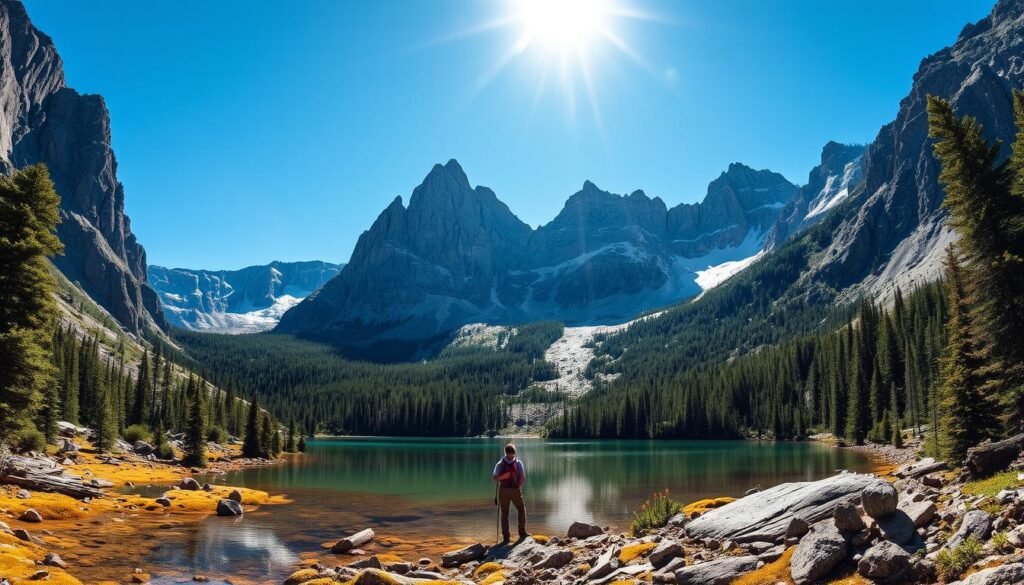
Why it stands out
I come here when I want views for days and minimal red tape. The lack of 14,000-foot peaks keeps the buzz low while lakes and ridges reward route-finding.
How I link Gore Creek, Gore Lake, Deluge Lake
My usual link-up starts up Gore Creek to Gore Lake at about the 6 mile mark. From there I climb off-trail toward Snow Pass and drop to Deluge Lake near mile 12 total.
Quick stats
| Route | Miles | Gain (feet) | Season / Permit |
|---|---|---|---|
| Gore Creek → Gore Lake | ~6 miles | ~1,800 feet | Late Jul–Sep / standard wilderness regs |
| Snow Pass → Deluge Lake loop | ~12–14 miles | ~3,000–3,800 feet | Late Jul–Sep / no quota permit |
| Water & crowds | Reliable | Light near lake; sparse off-trail | Bring map & compass |
My alpine pack list
- Stable trekking poles and grippy shoes for talus and alpine rock
- 2–3L hydration with filter, light puffy, shell, sun hat
- Microspikes if early season, small med kit, emergency bivy
I treat this as an adventure day: early start, weather checks, and clear bail routes. With a paper topo and steady feet, the high country here delivers quiet views and real solitude.
Gap Run ridges and pools in Shenandoah’s quiet South District
I often start before sunbreak to catch the first light across Gap Run Valley. This sets a calm tone for a 9.8-mile lollipop that links Rocky Mount and Gap Run trails inside Shenandoah National Park.
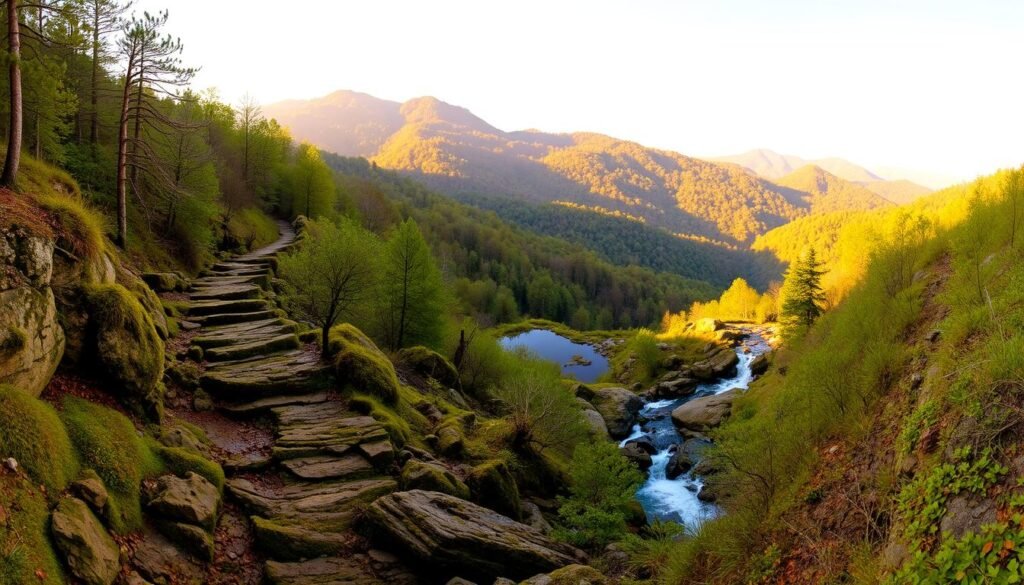
Rocky Mount–Gap Run lollipop for Blue Ridge views and campable hollows
I park early, then climb Rocky Mount to watch the sun slide along the Blue Ridge. The summit gives long views into Shenandoah Valley that feel big for modest miles.
At the lollipop stick I commit to the full loop: open knobs first, then a cool-down under forest as Gap Run gurgles beside the trail. The creekside real estate between miles 5.4 and 6.4 is where I stop for a quick lunch.
Light-and-fast gear I carry for a nine-to-ten-mile Appalachian day
- 12–18L daypack, 1.5–2L water and a squeeze filter for creek treatment
- Sun hat, UPF shirt for ridge sections, and light layers for changing weather
- Trail runners with good tread, compact first aid, headlamp, and map (paper)
- Snacks that lift morale on the last ridge and a small trash bag to pack out waste
Expect a friendly grade with a couple punchy climbs—ideal for hikers stretching past a 5–7 miles habit. I carry a paper map and confirm bearings at signed junctions.
On warm days I start early to dodge midday sun and on busy weekends an early car keeps encounters low. Respect trail etiquette: yield uphill, step on durable surfaces, and keep chatter low so the forest can do the talking.
Jones Hole to Ely Creek oasis in Dinosaur National Monument
A short walk from the hatchery drops you into a cool, narrow ribbon of shade and constant creek sound. In barely 1.5 miles the canyon walls rise and Ely Creek feels like a small, private world.
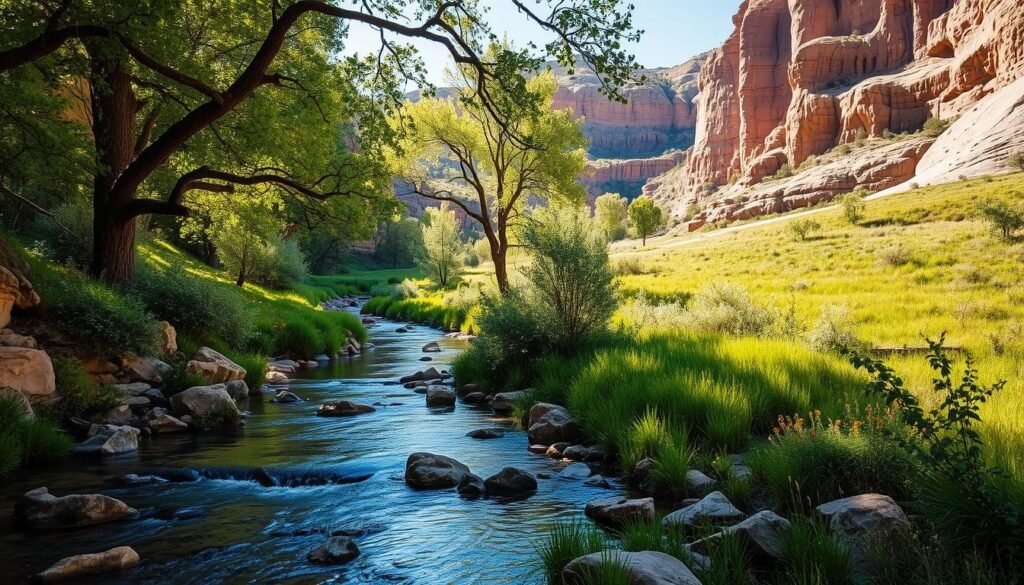
Petroglyphs, perennial water, and sunset walls
Pitch camp on the designated far side of the bridge and you have a compact basecamp with reliable water even through hot summer days. Rock panels nearby hold Fremont-era petroglyphs and pictographs that reward a quiet, respectful pause.
My hike plan: hatchery to Ely Creek basecamp and side trips
I start at the fish hatchery and hike 1.5 miles down Jones Hole Trail to Ely Creek. After I set a small camp, I stash heavy gear and walk about 0.4 mile west to the best swimming hole for a cooling dip.
Late afternoon I follow Jones Hole toward the Green River and Whirlpool Canyon, roughly 1.5 miles south, for golden light on steep walls. Short miles and a long, lazy day work well here.
Desert creekside kit to keep cool and safe
- 2L carry capacity plus a quick filter (treat creek water)
- Wide-brim hat, UPF long sleeve, and a bandana to dip and drape
- Lightweight sandals or water shoes, quick-dry shirt and shorts
- Electrolytes, basic first aid, and a small pack for day-side trips
Respect cryptobiotic soil and stay on durable surfaces. Weather can flip with a monsoon pulse, so I check conditions and give the canyon space when flows rise. This is a friendly place for newer backpackers and families — a short trip that still feels like real canyon time.
Indian Point sunrise camp above Garden of the Gods Wilderness
An east-facing outcrop and a quiet night make sunrise feel like a private ritual. I reach Indian Point from the Hitching Post Equestrian trailhead and follow the River to River Trail until I hit the south turn at about mile 5.1.
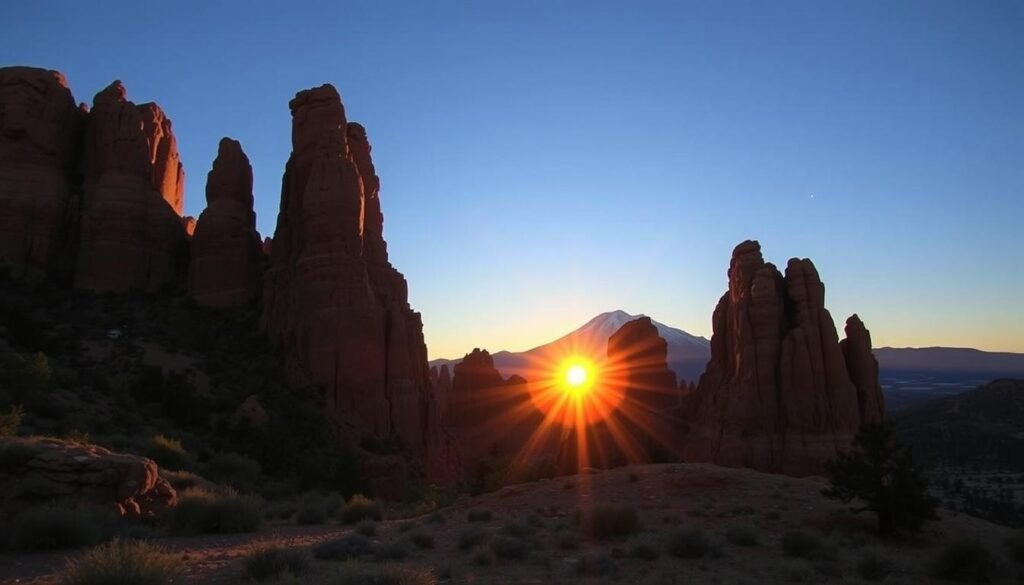
Route notes from the River to River Trail spur
The final approach threads weathered rock corridors and wind-scrubbed ledges. It then pops onto a 300-foot outcrop with an east-facing campsite tucked back in the trees.
I camp a step off the ledge to give the sandstone room and keep my footprint small. At first light the rock glows and the forest below opens into wide views. Watch your step—sandstone can crumble under careful feet.
A minimalist bivy kit that keeps weight low
- Water-filtering soft bottle
- Quilt and foam pad and a snug bivy sack
- Compact headlamp, small stove for coffee, and a warm beanie
- Light wind layer and a few guy lines—guying the bivy matters on exposed ledges
Evening is quiet here: no music, just night calls and stars. I set my camera before dawn so I can drink coffee and watch the sun lift cleanly over the hardwoods.
Redwood Canyon’s giant sequoia loop in Kings Canyon National Park
A soft carpet of duff and the smell of resin mark the moment I step under sequoias. I link Redwood Creek and Sugar Bowl Trails to form a gentle 6.5-mile loop that feels slow and deliberate.
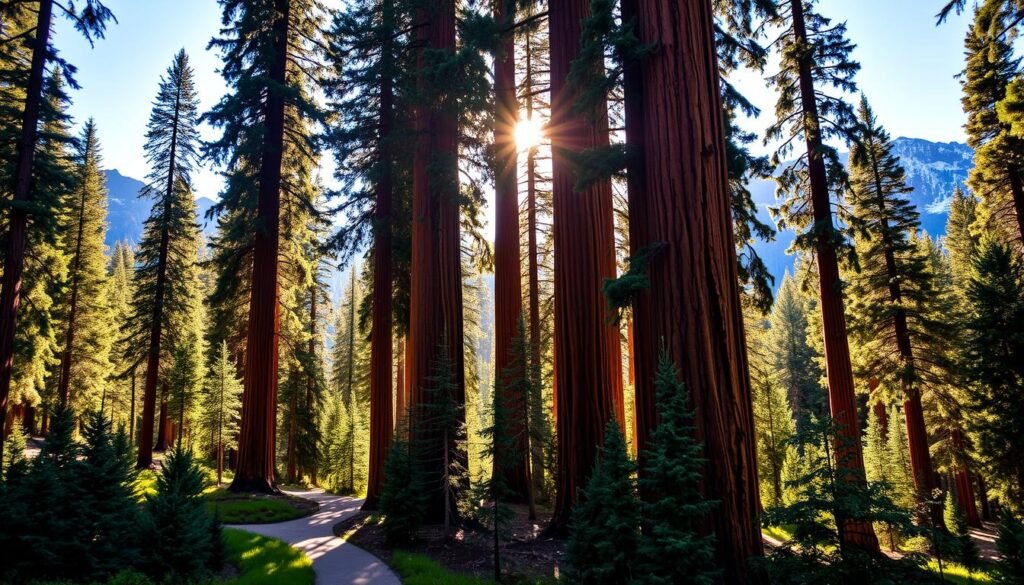
Redwood Creek and Sugar Bowl trails: soft duff, sky-high trees, easy water
I hike clockwise: Redwood Creek first for easy water access and soft warming miles, then Sugar Bowl for a steady climb through towering trunks. I aim to camp near mile 1.9 inside Redwood Mountain Grove, where trees approach 300 feet and 20 feet across.
Quick stats
| Route | Miles | Gain (feet) | Season / Permit / Bear Can / Crowds |
|---|---|---|---|
| Redwood Creek → Sugar Bowl loop | ~6.5 miles | ~1,200–1,600 | Late spring–fall / standard backcountry permit / canister recommended / light |
| Overnight camp (grove) | ~1.9 mile in | Minimal | Designated or compliant sites only |
| Water | Reliable | — | Filter from Redwood Creek; avoid bank trampling |
What I pack for sequoia grove overnights in summer
- Breathable layers for warm afternoons and a light fleece for cool nights.
- Canister stove, bear canister, and long spoon for no-mess meals.
- Lightweight shelter, small filter, and a head net if skeeters appear.
- Map, headlamp, and a small first-aid kit; step wide around roots and avoid camping at a tree base.
I treat the grove with quiet respect: keep scents sealed, use durable surfaces, and wander at golden hour to watch sun hit cinnamon bark. For a national park overnight that feels miles from pavement, this loop is a slow, restorative way to meet ancient trees and old forests.
Sal Hollow’s quiet karst woods in Mammoth Cave National Park
I set out from Maple Springs and let the hardwoods set a patient pace as the trail bends toward Sal Hollow’s rim. The canopy of beech, maple, and hickory makes the day feel cool and slow, even on humid afternoons.
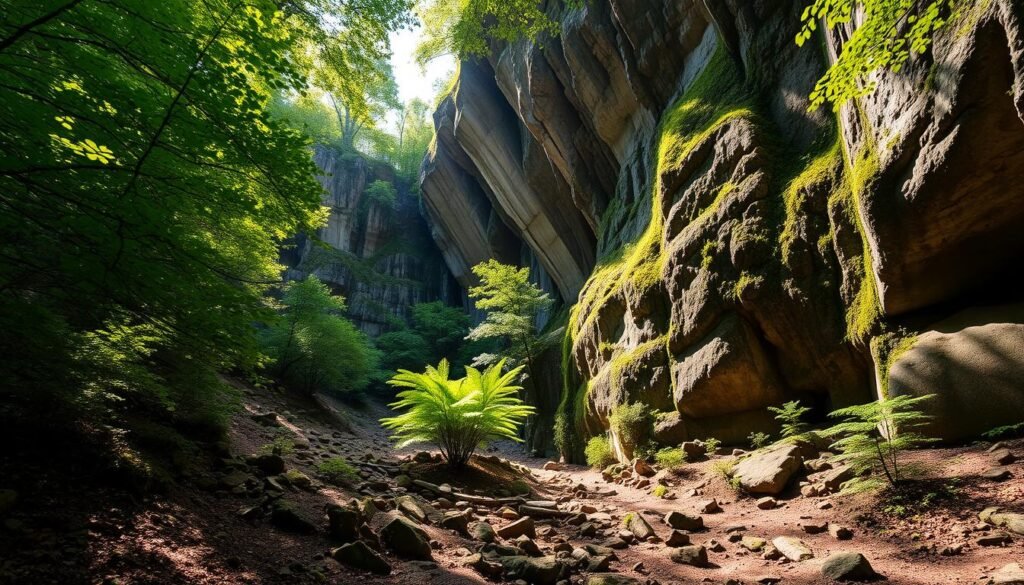
Maple Springs to rim camp and the Buffalo Creek return
From Maple Springs I follow Sal Hollow Trail about 7.4 miles southwest to a small rim camp tucked back in the trees. The site is level and quiet—good for a single tent and a book at dusk.
Next morning I close the loop on Buffalo Creek Trail to make an ~11.7-mile circuit. The return feels fresh because the creek corridor changes the scene and pace.
| Segment | Miles | Notes |
|---|---|---|
| Maple Springs → Rim camp | ~7.4 miles | Shaded, level campsite on rim |
| Rim camp → Buffalo Creek → Trailhead | ~4.3 miles | Creek corridor, varied tread |
| Total loop | ~11.7 miles | Two-day pace; easy navigation |
Shoulder-season essentials for humid hardwood miles
- Carry a light rain shell and pack liner—humidity makes short showers feel heavy.
- Use poles for slick leaf litter and creek approaches; do tick checks at camp.
- My kit: 1.5–2L water with filter, breathable sun hoodie, aggressive-lug trail runners, and a small repair kit.
Sahale Glacier Camp, North Cascades: high-alpine sleeping with star-field peaks
A high, wind-scoured bench above the tree line makes Sahale feel like a small world suspended among glaciers. I reach it after a steady climb that shifts from forest to wildflower meadows and then to talus at high angle. The camp sits beside Sahale Glacier and the constant hum of ice is part of the night soundtrack.
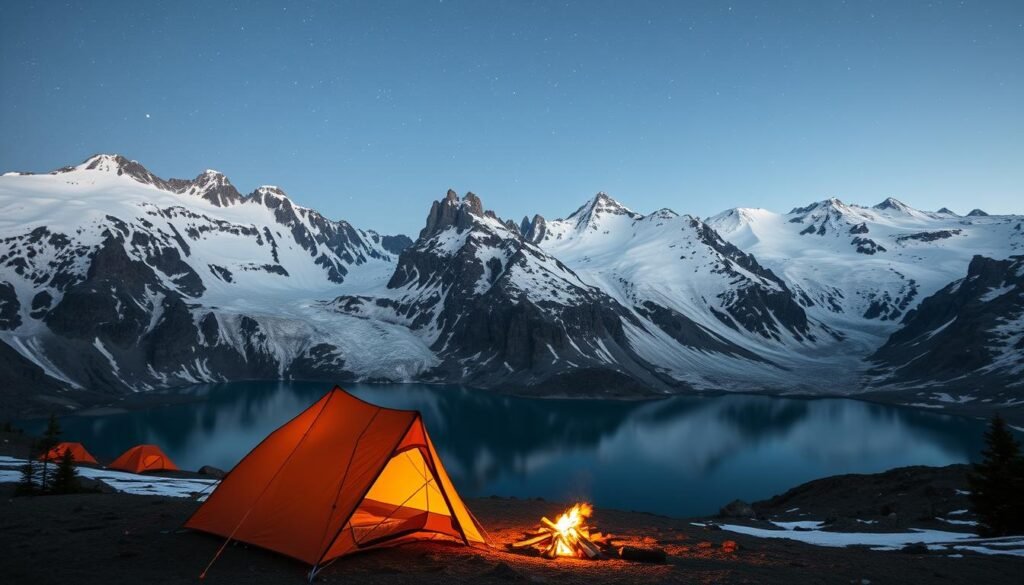
Snagging the permit and timing the wildflower window
I apply for the permit the moment the quota opens and keep flexible dates. Permits are mandatory and competitive for this national park spot, so patience and backups matter.
Wildflowers usually peak late July into August if the snowpack cooperates. I check recent trip reports for lingering snow and cornices before locking a date.
My ascent plan: Cascade Pass to Sahale Arm to 7,600-foot camp
The route breaks neatly: Cascade Pass at about 3.4 miles, then the Sahale Arm through meadows and talus to camp near 7,600 feet at roughly 5.5 miles from the trailhead. I treat the final approach as alpine travel and move deliberately.
Quick stats
| Segment | Miles (round) | Gain (feet) | Season / Permit | Snow travel |
|---|---|---|---|---|
| Cascade Pass → Sahale Glacier Camp | ~11 miles | ~4,000 feet | Mid/late summer–early fall / mandatory permit | Likely early season; microspikes/axe |
| Crowd note | — | — | Pass busy; camp usually sparse | Adjust plans if late snow persists |
Glacier-edge kit I trust
For glacier-adjacent overnighting I carry microspikes or light crampons, an axe if snow is present, sturdy poles, and a warm puffy. My sleep system is rated 20–25°F with a closed-cell pad under an inflatable for comfort at altitude.
I anchor guylines and stack rocks for wind protection, store food in approved containers, and make conservative weather calls. The views and star fields here reward careful planning; but safety and leave-no-trace habits keep the place wild for other hikers.
Charon’s Garden in the Wichita Mountains: granite domes, bison, and big-sky prairie
I drive a short road into the refuge and step onto sandy tread that leads straight into boulder gardens. The trail opens onto a rock-strewn meadow where bison often graze and Elk Mountain anchors the skyline.
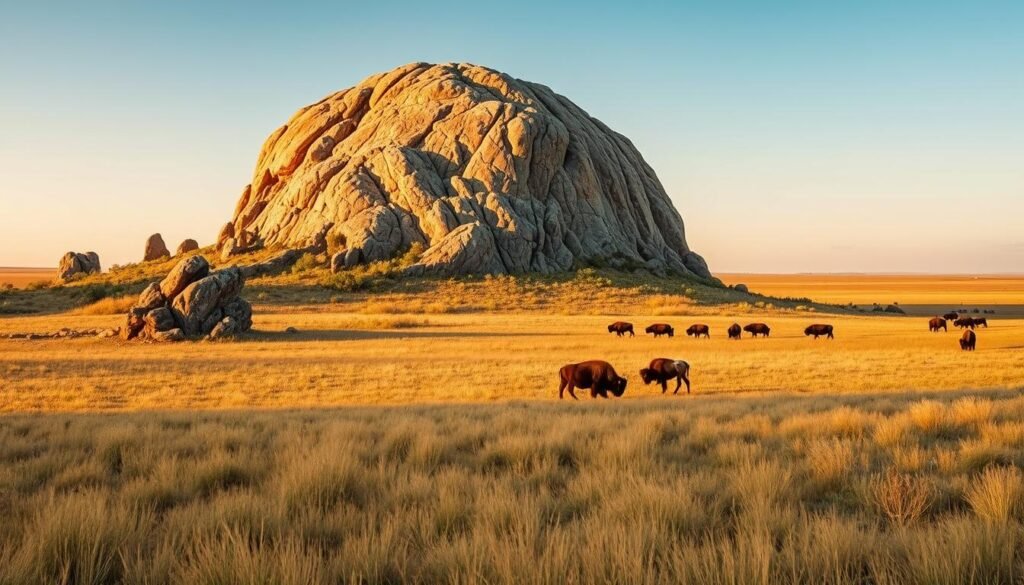
Out-and-back overview to the boulder meadow
The Charon’s Garden Trail is an out-and-back of roughly 4.8 miles. It feels honest and easy on good weather, but exposure to sun and wind makes the stretch feel larger than the miles suggest.
Granite outcrops punctuate the prairie here, and the refuge protects a large herd of bison and elk. Camp spots sit nearby for an extended stay under big sky.
My Great Plains day-hike checklist for wildlife and weather
- Brimmed hat, sunglasses, and 2L water minimum with electrolyte tabs for heat and wind.
- Printed map, sturdy shoes with good friction on rock, and a light wind layer.
- Scan for bison early; if they block the trail I give them the whole area and reroute.
- Check forecasts—thunderheads build fast; I retreat at the first rumble rather than race back to the road.
- If I plan slab climbing I bring a rope, helmet, and partner; otherwise I stick to low-angle slabs with clean runouts.
- Time your turnaround so you don’t finish the day hiking after dark; prairie light near sunset is worth the pause.
Mt. Cabot and the Pilot Range: New Hampshire’s quiet high country
I start beneath hardwoods and climb into a ridge where rock ledges open toward wide northern views. The loop threads Mill Brook, Kilkenny Ridge, and Bunnell Notch for a long, honest day with ledges and still water as reward.
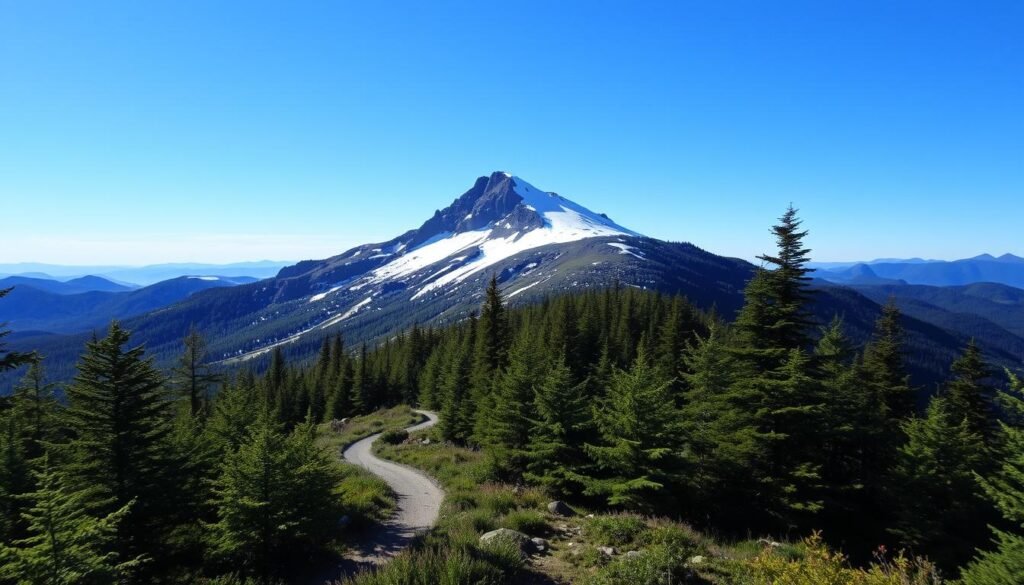
Looping Kilkenny ridges to Unknown Pond and big-view rock ledges
I begin low on Mill Brook and gain the Kilkenny Ridge where Rogers Ledge, The Horn, The Bulge, and Mt. Cabot reveal themselves. Unknown Pond at about mile 6.7 is my halfway gem; Campsite #5 sits lakeside and the Horn mirrors on calm evenings.
Quick stats
| Route | Miles | Gain (feet) | Season / Notes |
|---|---|---|---|
| Mill Brook → Kilkenny Ridge → Bunnell Notch loop | ~16.3 miles | ~4,000–4,600 | Late spring–fall; treat water |
| Water & bugs | Streams & pond | — | Black fly season early; carry headnet |
| Crowds & feel | Light | — | Quiet compared to Presidential peaks; true wilderness feel |
What saves my day in the Whites: traction, headnet, map-and-compass
Cabot isn’t the highest point in the Whites, but its ledges reward those avoiding peak crowds. The ridge can feel remote; I pack an extra layer and a spare headlamp if fog or slow miles force a late exit.
My must-haves: microspikes for shoulder snow, a headnet for black flies, a paper map and compass even with GPS, and a small repair kit for wet straps or broken buckles. I eat on ledges but watch the wind—one gust will steal a wrapper and a moment.
10 Top Hiking Adventures in U.S. Mountain Ranges You’ve Probably Never Heard Of: permits, seasons, and safety I live by
The calendar is my first piece of gear; I lock permits, then build an itinerary that respects wildlife and weather. I plan windows for snowmelt, ferry caps, and quota openings so a plan becomes a real trip across the united states.
Timing and permit basics
Permit systems vary: some sites use competitive lotteries, others require a simple backcountry reservation. I set reminders for applications and keep a Plan B if a slot slips away.
Wildlife, heat, and high-country sun
Give animals space: in prairie and refuge areas I yield to bison, and in forested park country I carry bear spray where appropriate. For desert canyons I start early, sip electrolytes, and use UPF layers to cut sun load.
My universal packing template
- Pack size: 20–35L day or 45–55L overnight; map and compass; headlamp with spare.
- Essentials: first aid, water filter, repair tape, multi-tool, trekking poles, power bank.
- Clothing: extra warm layer, waterproof shell, sun kit (hat, SPF, lip balm), gloves if needed.
I plan checkpoints and buffer time, and I turn back without ego if weather or people slow us down. Good planning is the way I keep trips safe and simple.
Ready for your next quiet summit? Here’s how I choose the day, load the pack, and step into the morning
Ready for your next quiet summit? Here’s how I choose the day, load the pack, and step into the morning.
I pick a date on the calendar and treat it like a pact with the trail. I scan maps of the united states and north america, shortlist two or three places that fit the season, then protect the date like a birthday.
My pack is a living checklist. I cut weight for the miles and feet I plan to move, lay out layers and food the night before, and write key turns and mile marks on a small card for sunrise starts.
On the road I settle my head so the first mile sets the pace. I leave room in the day to linger on a side spur or top ledge and let the place work on me. That way each trip feels like a small, kept promise to the world of quiet trails and wide views.





